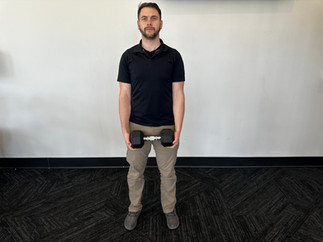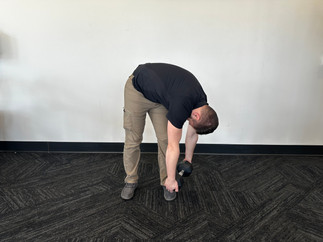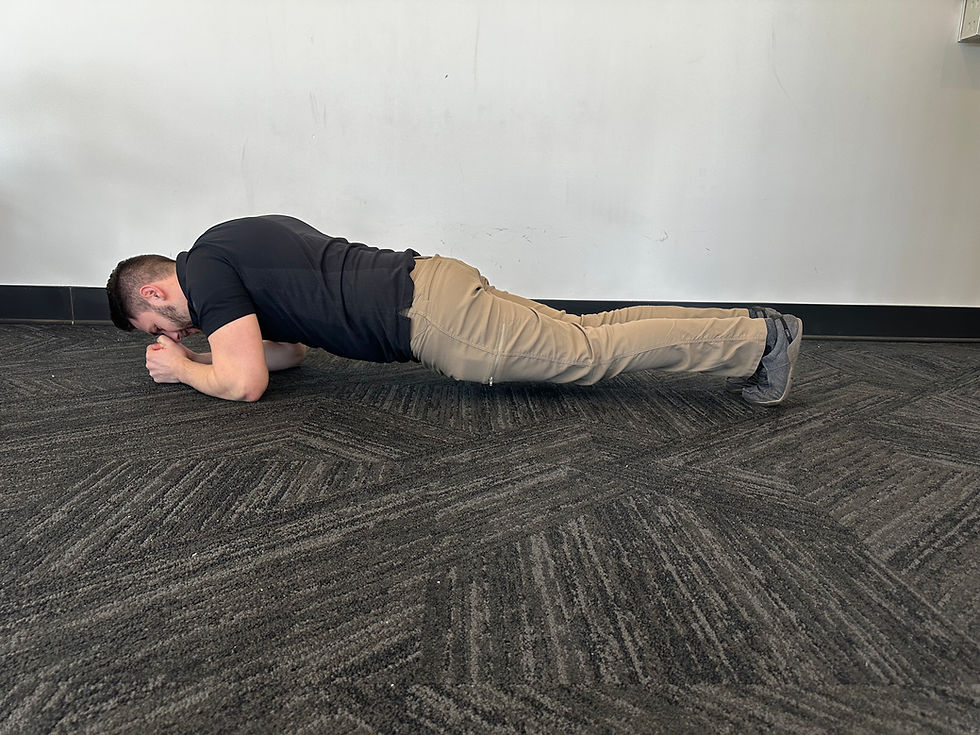Jefferson Curl Exercise
- Benjamin Mishleau
- Jan 22
- 3 min read
Updated: Mar 4
The Jefferson Curl exercise is named after Charles Jefferson, a famous circus strongman known for his weightlifting feats performed in unusual positions. It is highly effective for strengthening the lower back and core while stretching the hamstrings. One of its greatest benefits is its ability to prepare the body for everyday tasks that might otherwise strain the back, such as picking up a heavy shopping bag or child from the floor when not in an ideal lifting posture.
Purpose: Improves spinal flexibility and stability, hamstring flexibility, and control over the posterior chain. Builds strength along all segments of the spine.
Target Areas: Spine, lower back, hamstrings, glutes, and calves.
Instructions:
Stand upright with your feet hip-width apart while holding a light weight, such as a dumbbell or kettlebell, in front of your body with both hands. Keep your arms straight and relaxed, letting the weight hang naturally.
Begin by tucking your chin to your chest, initiating the movement with your neck.
Slowly roll down through your spine one vertebra at a time, allowing your upper back, mid-back, and lower back to round sequentially. Keep your knees straight (but not locked) as you reach toward the floor with the weight, feeling a stretch in your hamstrings. Lower as far as your flexibility allows while maintaining control and avoiding any jerky movements.
Reverse the movement by slowly unrolling your spine, starting with your lower back and moving upward. Finish with your neck and head returning to an upright position.
Perform 6–8 slow, controlled repetitions for 2–3 sets.
Tips:
Move slowly and deliberately to engage the correct muscles and avoid strain.
Start with very light weight or no weight if you're new to this exercise.
Keep your core engaged throughout to support your lower back.
Avoid locking your knees or forcing the range of motion beyond your current flexibility.
Who Should Do the Jefferson Curl?
The Jefferson Curl is a loaded spinal flexion exercise that improves hamstring flexibility, spinal mobility, and lower back strength when done correctly. It is ideal for:
Athletes & Gymnasts: Those who need exceptional spinal mobility and control, such as gymnasts, dancers, and martial artists, can benefit from Jefferson Curls to build strength and resilience in end-range spinal flexion.
Advanced Lifters & Experienced Trainees: Individuals with a strong foundation in strength training who understand proper spinal mechanics and have built core stability can safely incorporate this exercise for mobility and control.
People Looking to Improve Posterior Chain Flexibility: This exercise lengthens the hamstrings, strengthens the erectors, and improves spinal articulation, making it beneficial for those who want to enhance their flexibility.
Individuals with Good Spinal Control: Those who can perform bodyweight spinal flexion exercises without pain and have a strong core can benefit from Jefferson Curls as a controlled mobility drill.
Who Should Avoid or Modify the Jefferson Curl?
While the Jefferson Curl can be beneficial, it may not be suitable for everyone:
People with Existing Back Issues (Herniated Discs, Sciatica, or Chronic Back Pain): Since the movement involves intentional spinal flexion under load, it can aggravate pre-existing lower back conditions, particularly for those with disc injuries or instability.
Beginners or Those New to Strength Training: This is an advanced mobility drill that requires a high level of body awareness and control. Beginners should first develop spinal control through bodyweight movements before attempting the Jefferson Curl.
Individuals with Poor Core Strength: A strong core is essential to stabilize the movement. If core weakness is present, there is a higher risk of compensatory movements leading to strain.
People with Osteoporosis or Other Bone Density Issues: Those with bone fragility should avoid this movement, as the flexion under load can increase the risk of injury.
Pregnant Women: Due to changes in spinal curvature and core stability during pregnancy, this movement may place excessive strain on the lower back and should be avoided.
Anyone Experiencing Pain During the Movement: If discomfort or pain occurs at any point during a Jefferson Curl, the exercise should be stopped immediately. Proper form and progressive loading are key to avoiding injury.













Comments